Science Advances: Exercise can prevent or even reverse insulin resistance
- Statins Lower Blood Lipids: How Long is a Course?
- Warning: Smartwatch Blood Sugar Measurement Deemed Dangerous
- Mifepristone: A Safe and Effective Abortion Option Amidst Controversy
- Asbestos Detected in Buildings Damaged in Ukraine: Analyzed by Japanese Company
- New Ocrevus Subcutaneous Injection Therapy Shows Promising Results in Multiple Sclerosis Treatmen
- Dutch Man Infected with COVID-19 for 613 Days Dies: Accumulating Over 50 Virus Mutations
Science Advances: Exercise can prevent or even reverse insulin resistance
- Red Yeast Rice Scare Grips Japan: Over 114 Hospitalized and 5 Deaths
- Long COVID Brain Fog: Blood-Brain Barrier Damage and Persistent Inflammation
- FDA has mandated a top-level black box warning for all marketed CAR-T therapies
- Can people with high blood pressure eat peanuts?
- What is the difference between dopamine and dobutamine?
- How long can the patient live after heart stent surgery?
Science Advances: Exercise can prevent or even reverse insulin resistance.
Run more, don’t look for diabetes! Scientists have discovered that exercise induces skeletal muscle to express an enzyme, which can enhance muscle function, prevent or even reverse insulin resistance
Life lies in exercise, exercise maintains health.
The prevalence of metabolic diseases such as insulin resistance and type 2 diabetes in modern society is closely related to the general lack of human labor and exercise [1].
However, the role of lack of exercise in the pathophysiology of type 2 diabetes and how exercise can improve insulin resistance still puzzles the majority of medical researchers .
Not long ago, Science Advances, a sub-issue of the top international journal “Science”, published a major research result in the field of endocrinology and sports medicine by Professor Tony Tiganis of Monash University in Australia [2].
They found that exercise promotes ROS-mediated adaptive response by inducing the expression of skeletal muscle NOX4, thereby enhancing muscle function, maintaining redox balance, and reversing insulin resistance .
This discovery reveals in detail the mechanism by which exercise maintains blood sugar health from the perspective of oxidative stress, and provides a potential therapeutic target for insulin resistance related to aging and obesity.
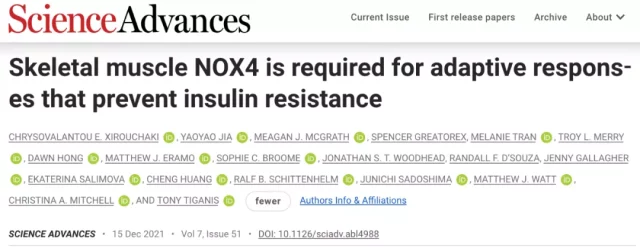
▲ This paper onScience Advanceswebsite
In the past, a number of animal experiments and population experiments have confirmed that exercise can promote mitochondrial production and increase insulin sensitivity [3].
Some studies believe that this is related to the generation of ROS caused by exercise and the activation of the KEAP1/NFE2L2 pathway .
ROS is a natural by-product of cell respiration, including H 2 O 2 , O 2 • − and • OH, etc. It is the endogenous oxidant of cells. The production of ROS during exercise is mainly catalyzed by the NOX family.
Among them, NOX4 is located in skeletal muscle cells and can directly produce H 2 O 2 and O 2 • − .
After exercise, ROS oxidizes KEAP1, causing the transcription factor NFE2L2 that binds to KEAP1 to be released into the nucleus, promoting the expression of mitochondrial-related genes and antioxidant defense system genes .
However, so far, the detailed mechanism has not been fully elucidated.
Therefore, the Tiganis team used NFE2L2 and NOX4 as a breakthrough point.
First, they tested the changes in the skeletal muscles of mice and humans before and after exercise, and found that the expression of NFE2L2 and NOX4 was up-regulated after exercise .
Considering that NFE2L2 can bind to the NOX4 promoter region, the researchers concluded that NOX4 is the target gene of NFE2L2, and exercise promotes NOX4 expression by up-regulating NFE2L2.
In order to prove this hypothesis, the Tiganis team used the activator of NFE2L2-radish (lái fú, radish) sulfane instead of exercise to stimulate NFE2L2, conducted cell and animal experiments to observe the expression of NOX4.
They found that after myoblasts and mice were treated with sulforaphane, NOX4 expression increased; after knocking out NFE2L2, sulforaphane treatment could not increase NOX4 expression. This result verified their conjecture.
Subsequently, the Tiganis team studied the effect of skeletal muscle NOX4 loss on ROS production and found that after NOX4 in myoblasts was knocked out, H 2 O 2 production was reduced , and H 2 O 2 excitation and production during exercise was also eliminated .
This proves that skeletal muscle NOX4 is necessary for ROS generation. In addition, after specifically knocking out NOX4 in mouse skeletal muscle, while ROS production is reduced, exercise capacity and exercise endurance are also significantly reduced.
So what is the relationship between reduced ROS generation and reduced exercise capacity?
Considering that the oxidoreductase GPX-1 can eliminate ROS by reducing H 2 O 2 , the Tiganis team silenced the GPX-1 gene of NOX4 knockout mice to offset the reduction in ROS caused by NOX4 knockout.
They found that after knocking out GPX-1, the locomotor ability and endurance of NOX4 knockout mice returned to normal with H 2 O 2 levels. Therefore, NOX4 knockout of skeletal muscle impairs exercise performance by reducing H 2 O 2 production .
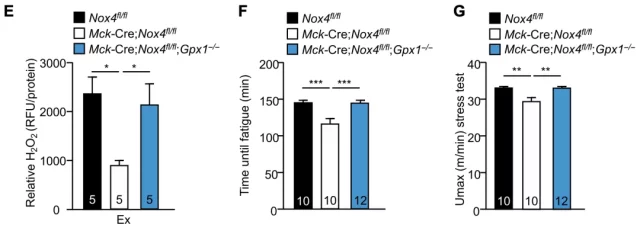
▲ Figure E: The production of H2O2 isreduced after NOX4 is knocked out, and it can be restored after knocking out GPX-1; Figure F and G: The production of mouse motor ability is reduced after NOX4 is knocked out, and after GPX-1 is knocked out Can be restored. (Nox4fl/flis the control wild-type mouse, Mck-Cre; Nox4fl/flis the experimental group skeletal muscle NOX4 knockout mouse, Mck-Cre; Nox4fl/fl, Gpx1-/-is the experimental group skeletal muscle GPX- 1 Double knockout mouse with NOX4)
Previous studies have shown that the strength of exercise capacity is related to the content of skeletal muscle mitochondria [4].
Therefore, the Tiganis team compared the expression of related genes in the skeletal muscle of GPX-1 and NOX4 double knockout mice, NOX4 knockout mice and normal mice, and found mitochondrial genes (Pcg1a, Nrf1, Nrf2 and Tfam) and genes related to the mitochondrial respiratory chain , The expression decreased after NOX4 was knocked out, and after GPX-1 was knocked out on the basis of NOX4 knock out, the expression was restored.
This result has also been verified in NOX4 knockout myoblasts, proving that skeletal muscle NOX4 knockout inhibits mitochondrial production by reducing H 2 O 2 levels, thereby impairing the exercise ability of mice .
In fact, studies have found that NFE2L2 participates in exercise-induced mitochondria production, and the NFE2L2 activator sulforaphane can enhance the exercise capacity of mice.
Therefore, the Tiganis team speculated that the reduction in exercise capacity caused by the reduction of mitochondrial production in NOX4 knockout mice may be related to the loss of NFE2L2.
Using sulforaphane to treat NOX4 knockout mice, it was found that the decrease in NFE2L2 expression caused by NOX4 knockout was corrected and the decrease in mitochondrial-related gene expression was inhibited.
The exercise endurance test found that the sulforaphane treatment rescued the decline in exercise endurance of NOX4 knockout mice .
These findings prove that skeletal muscle NOX4 knockout inhibits NFE2L2 by reducing H 2 O 2 , thereby weakening mitochondrial production and ultimately impairing exercise capacity .
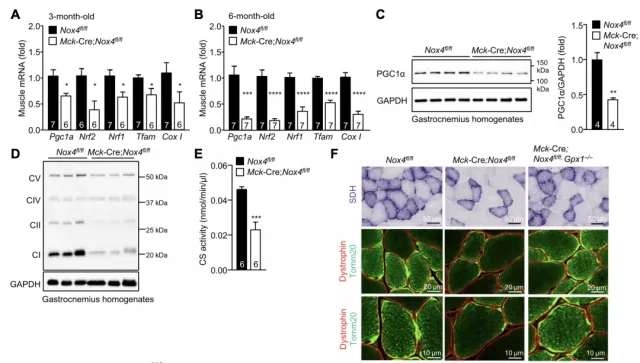
▲ Figure AC: The expression of mitochondrial genes decreases after NOX4 knockout; Figure D and E: The expression of mitochondrial respiratory chain related genes decreases after NOX4 knockout; Figure F: Mitochondrial production decreases after NOX4 knockout (green fluorescence indicates mitochondrial density )
The Tiganis team noticed that skeletal muscle contraction produces ROS, which can enhance the antioxidant defense mediated by NFE2L2 [5].
Moreover, previous experiments have proved that NOX4 is necessary for muscle contraction to produce ROS. Therefore, Tiganis and his colleagues hypothesized that NOX4 is related to antioxidant defense, that is, the lack of NOX4 can lead to defects in antioxidant defense.
Cell and animal experiments found that NOX4 knockout caused the decrease in the expression of NFE2L2 and NFE2L2 target genes, and eliminated the promotion of exercise on the expression of NFE2L2.
Unbiased proteomics and WB confirmed that the expression of antioxidant defense genes decreased (mitochondrial SOD2, GCLM, PRDX6, NQO1, PRDX1 to PRDX3 and H 2 O 2 enzymes) , lipid peroxidation (4-HNE), protein oxidation and damage (Protein carbonylation) and muscle damage (CK) and other oxidative damage increased.
Knockout of GPX-1 on the basis of NOX4 knockout to inhibit the reduction of H 2 O 2 can greatly rescue the decline in the expression of antioxidant defense genes and reduce the oxidative damage of skeletal muscle.
Therefore, skeletal muscle NOX4 knockout inhibits NFE2L2 by reducing H 2 O 2 , thereby weakening the antioxidant defense and increasing oxidative damage .
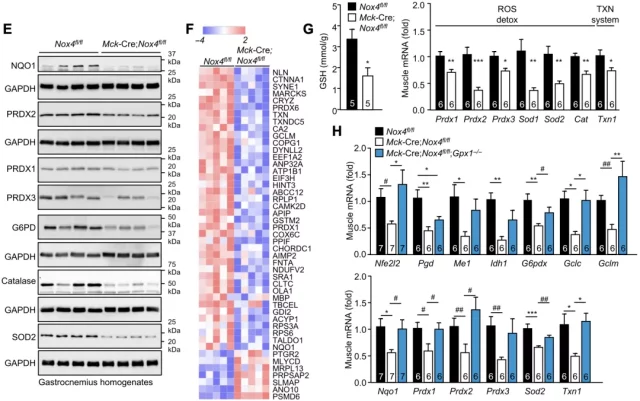
▲ Figure E (WB), Figure F (unbiased proteomics) and Figure G and H (RT-PCR): detection of antioxidant defense genes after NOX4 knockout expression decreased; Figure I (4-HNE), Figure J (Protein carbonylation) and Figure K (CK): Detection of oxidative damage genes up-regulated after NOX4 knockout
In view of the fact that insulin resistance caused by aging and type 2 diabetes are related to oxidative damage.
Based on the NOX4/ H 2 O 2 /NFE2L2/antioxidant defense signal axis discovered in the above experiment , Tiganis and his colleagues further speculated that the insulin resistance of aging mice may be attributed to the decrease of NOX4 expression.
Researchers compared the expression of NOX4 in aging mice and young mice and found that the expression of NOX4 in skeletal muscle of aging mice decreased by 46% ! Later, the researchers also found that the blood glucose and insulin levels of NOX4 knockout mice increased after meals, the insulin response was weakened, the glucose uptake of skeletal muscles was reduced, and insulin resistance appeared.
Knockout of GPX1 to accumulate H 2 O 2 in NOX4 knockout mice , or take sulforaphane to activate NFE2L2, can reverse the insulin resistance in NOX4 knockout mice.
Obesity can also promote insulin resistance by exacerbating oxidative stress throughout the body [6].
The Tiganis team found that NOX4 expression in skeletal muscle of obese mice induced by diet was reduced by 44% !
Therefore, they boldly speculate: NOX4 deficiency can exacerbate insulin resistance caused by diet-induced obesity.
Tiganis and his colleagues evaluated the muscle development and glucose homeostasis of NOX4 knockout mice after a high-fat diet.
They found no changes in body weight, body composition and muscle tissue morphology, but decreased skeletal muscle mitochondria production, increased insulin resistance, and reduced glucose.
Increased tolerance, decreased glucose uptake capacity of skeletal muscle, decreased insulin signal transduction ( decreased phosphorylation level of AKT at Ser473) , and decreased insulin sensitization effect caused by exercise.

▲ Figure C and Figure E: Insulin tolerance test found that blood glucose level increased after NOX4 knockout, and insulin response weakened; Figure D: AKT phosphorylation level at Ser473 decreased after NOX4 knockout, treated with sulforaphane (SILF) After recovery.
Since the loss of mitochondrial SOD2 or the increase of ROS in mitochondria, it can reduce insulin signal transduction and promote insulin resistance.
So, is the insulin resistance caused by the weakening of NOX4/ H 2 O 2 /NFE2L2/antioxidant defense signal axis related to this?
Tiganis and colleagues first myoblasts after NOX4 knockout was tested and found in H 2 O 2 while decreased production and antioxidant defense gene expression reduced, reducing SOD2 expression mitochondria, the mitochondrial O 2 • – increasing , Protein carbonylation increases, and insulin signal decreases.
When NFE2L2 is activated with sulforaphane or knocking out KEAP1, protein carbonylation is reduced and insulin signal is restored. Using mitochondrial targeting antioxidants, SOD mimics, or mitochondrial targeting tetrapeptide SS31 to block mitochondrial O 2 • − production can also reduce protein carbonylation and restore defective insulin signaling.
These results indicate that the NOX4/ H 2 O 2 /NFE2L2/antioxidant defense/mitochondrial oxidative stress signal axis plays an important role in the development of insulin resistance .
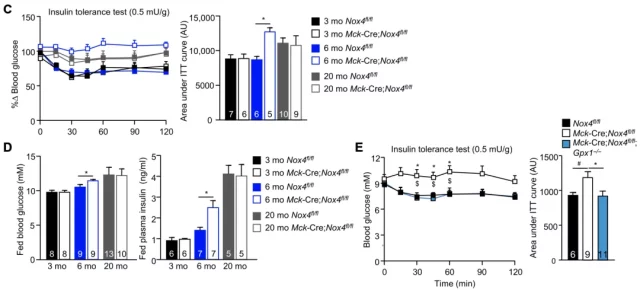
▲ Schematic diagram of the paper mechanism
Scientific research is a treasure hunt based on the known and unknown, and it is also a jigsaw puzzle that completes the fragments based on clues.
Digging for clues from the known clues, and then boldly verifying the hypothesis carefully, through delicately designed experiments, step by step, to clear the unknown fog, find the treasure of the phenotype, find the incomplete fragments, and fill the puzzle of the mechanism. This research by the Tiganis team is just that.
However, the fly in the ointment is that the experiment is mainly carried out around NOX4 knockout, and the experimental conclusions are only obtained by inversely based on the results of the loss of NOX4 function.
It may be better to combine the perspective of NOX4 function enhancement, such as constructing a NOX4 skeletal muscle-specific overexpression model at the same time, so as to explore and explain its role in the pathophysiology of mitochondrial production and insulin resistance from both sides.
“Keep your mouth shut and open your legs”, the second half of this six-character motto for preventing and treating diabetes is beyond imagination . So, for blood sugar health, don’t move quickly!
references
[1] Cartee GD, Hepple RT, Bamman MM, Zierath JR. Exercise Promotes Healthy Aging of Skeletal Muscle. Cell Metab. 2016;23(6):1034-1047. doi:10.1016/j.cmet.2016.05.007
[2] Xirouchaki CE, Jia Y, McGrath MJ, et al. Skeletal muscle NOX4 is required for adaptive responses that prevent insulin resistance. Sci Adv. 2021;7(51):eabl4988. doi:10.1126/sciadv.abl4988
[3] Egan B, Zierath JR. Exercise metabolism and the molecular regulation of skeletal muscle adaptation. Cell Metab. 2013;17(2):162-184. doi:10.1016/j.cmet.2012.12.012
[4] Merry TL, Ristow M. Mitohormesis in exercise training. Free Radic Biol Med. 2016;98:123-130. doi:10.1016/j.freeradbiomed.2015.11.032
[5] Merry TL, Ristow M. Nuclear factor erythroid-derived 2-like 2 (NFE2L2, Nrf2) mediates exercise-induced mitochondrial biogenesis and the anti-oxidant response in mice. J Physiol. 2016;594(18):5195-5207. doi:10.1113/JP271957
[6] Furukawa S, Fujita T, Shimabukuro M, et al. Increased oxidative stress in obesity and its impact on metabolic syndrome. J Clin Invest. 2004;114(12):1752-1761. doi:10.1172/JCI21625
Science Advances: Exercise can prevent or even reverse insulin resistance
(source:internet, reference only)
Disclaimer of medicaltrend.org
Important Note: The information provided is for informational purposes only and should not be considered as medical advice.



